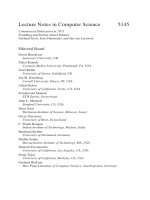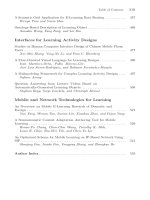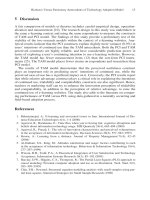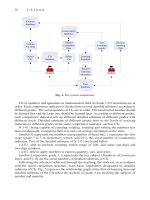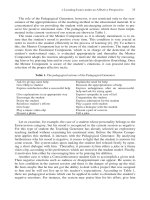Lecture Notes in Computer Science- P51 pps
Bạn đang xem bản rút gọn của tài liệu. Xem và tải ngay bản đầy đủ của tài liệu tại đây (649.98 KB, 5 trang )
Interactive Video Game Platform for Game-Based Learning 239
Table 2. Scores of questions with percentage
Score
Question 5 4 3 2 1 SUM
Q1 25.69% 46.79% 19.27% 5.50% 2.75% 98.20%
Q2 10.09% 61.47% 24.77% 3.67% 0.00% 98.20%
Q3 8.26% 49.54% 38.53% 3.67% 0.00% 98.20%
Q4 12.84% 53.21% 28.44% 4.59% 0.92% 98.20%
Q5 7.34% 45.87% 33.03% 11.93% 1.83% 98.20%
Q6 18.35% 44.95% 24.77% 8.26% 3.67% 98.20%
Q7 13.76% 47.71% 25.69% 9.17% 3.67% 98.20%
Q8 16.51% 38.53% 36.70% 7.34% 0.92% 98.20%
Q9 12.84% 55.05% 22.94% 8.26% 0.92% 98.20%
AVG 13.97% 49.24% 28.24% 6.93% 1.63%
STDEV 5.67% 6.63% 6.52% 2.79% 1.43%
Table 3. Scores of questions with accumulated percentage
Score
Question 5 4 3 2 1
Q1 25.69% 72.48% 91.74% 97.25% 98.20%
Q2 10.09% 71.56% 96.33% 100.00% 98.20%
Q3 8.26% 57.80% 96.33% 100.00% 98.20%
Q4 12.84% 66.06% 94.50% 99.08% 98.20%
Q5 7.34% 53.21% 86.24% 98.17% 98.20%
Q6 18.35% 63.30% 88.07% 96.33% 98.20%
Q7 13.76% 61.47% 87.16% 96.33% 98.20%
Q8 16.51% 55.05% 91.74% 99.08% 98.20%
Q9 12.84% 67.89% 90.83% 99.08% 98.20%
AVG 13.97% 63.20% 91.44% 98.37% 98.20%
two questions are Q5 and Q8. Users are not satisfied with time of switches between
video scenes and other media, the delay may be improved for better using experience.
Q8 indicates the drag and drop operation are not intuitional enough to users. Meaningful
interactions are required for combining users and learning scenarios. The average of
240 H B. Chang, H H. Hsu, and L.R. Chao
the 9 questions higher than score 4 is 63.20%, it means over 60% of users agree the per-
formance of the learning platform.
7 Conclusion
A platform use interactive video technologies is implemented to design video games
for educational purposes. Courses designers can easily produce contents with game
factors by this authoring tool. Video segments are used for scenarios in the VGBL
platform. These scenarios can be generated by cutting from films. Comparing to 3D
scenarios, it’s a cheaper way to produce game scenarios. Players can make interaction
with objects edited by the authoring tool and get feedback or switch to other scenar-
ios. Playing such games is attractive to students. Students can get experience and
knowledge by making interaction and decisions in game play.
References
1. Bing, J., Dubreuil, J., Espanol, J., Julia, L., Lee, M., Loyer, M., Serghine, M.: MiTV: re-
thinking interactive TV. In: The Proceedings of Seventh International Conference on Vir-
tual Systems and Multimedia, Berkeley, pp. 25–27 (2001)
2. Cesar, P., Vierinen, J., Vuorimaa, P.: Open graphical framework for interactive TV. In:
The Proceedings of Fifth International Symposium on Multimedia Software Engineering,
Taichung, pp. 10–12 (2003)
3. Champion, E.: Meaningful interaction in virtual learning environments. In: The Proceed-
ings of the second Australasian conference on Interactive entertainment, Sydney, pp.
41–45 (2005)
4. Lumbreras, M., Sanchez, J.: Hyperstories: a model to specify and design interactive educa-
tional stories. In: The Proceedings of XVII International Conference of the Chilean Com-
puter Science Society, pp. 135–146 (1997)
5. Martinez-Ortiz, I., Moreno-Ger, P., Sierra, J.L., Fernandez-Manjon, B.: Production and
Maintenance of Content-Intensive Videogames: A Document-Oriented Approach. In: The
Proceedings of Third International Conference on Information Technology: New Genera-
tions, pp. 118–123 (2006)
6. Muda, Z., Mohamed, R.E.K.: Adaptive User Interface Design in Multimedia Courseware.
In: The Proceedings of Information and Communication Technologies, pp. 196–199
(2006)
7. Natvig, L., Line, S.: Age of computers: game-based teaching of computer fundamentals.
In: The Proceedings of ninth SIGCSE conference on Innovation and technology in com-
puter science education (2004)
8. Moreno-Ger, P., Martínez-Ortiz, I., Sierra, J.L., Fernández-Manjón, B.: A Content-Centric
Development Process Model. IEEE Computer 41(3), 24–30 (2008)
9. Shim, S.S.Y., Lee, Y.J.: Interactive TV: VoD meets the Internet. IEEE Computer 35(7),
108–109 (2002)
10. Zhang, L.J., Chung, J.Y., Liu, L.K., Lipscomb, J.S., Zhou, Q.: An integrated live interac-
tive content insertion system for digital TV commerce. In: the Proceedings of Fourth In-
ternational Symposium on Multimedia Software Engineering, pp. 11–13 (2002)
F. Li et al. (Eds.): ICWL 2008, LNCS 5145, pp. 241
–
252, 2008.
© Springer-Verlag Berlin Heidelberg 2008
Developing the Historical Culture Course by Using the
Ubiquitous Game-Based Learning Environment
Jui-Hung Chen
1
, Te-Hua Wang
2
, Wen-Chih Chang
3
, and Louis R. Chao
1
1
Department of Computer Science and Information Engineering,
Tamkang University, Taiwan, R.O.C.
2
Department of Information Management
Chihlee Institute of Technology, Taiwan, R.O.C.
3
Department of Information Management, Chung Hua University, Taiwan, R.O.C.
Abstract. With the advance of information technologies, it is much easier to
provide and construct various powerful e-learning platforms. Nevertheless, such
kinds of e-learning platforms are available worldwide, but the percentage of us-
ing these platforms is still unsatisfactory. The main reason lies in the learning
content and learning activities couldn’t attract learner. Accordingly these
e-learning platforms are not able to fit the needs of either learners or instructors.
In this paper, we proposed an integrated learning environment called U-GBL
(Ubiquitous Game-Based Learning) system. We used the technologies in inter-
active video, GPS (Global Positioning System), GIS (Geographic Information
System) and RFID (Radio Frequency Identification) to construct the interactive
game-based learning environment. Learners could utilize PPC (Pocket PC) to
have the game-based learning activities anytime and anywhere. And we also
demonstrated an example of the historical culture course content to explain the
gaming scenario in our learning environment. We hope this U-GBL learning
platform could help to enrich the learning motivation and to improve the learn-
ing efficiency.
Keywords: GBL, Ubi-Media, Game Design, Game Authoring Tool.
1 Introduction
Nowadays, more and more researchers have discussed on how to make e-learning
systems more powerful and practicable. One essential issue lies in the attraction of
learning content [1, 2]. They pointed out gaming implied some important elements,
such as mission challenge, rewards and various fantasy content styles, to improve the
learners’ learning motivation. Another work [3] examines the behavior between gam-
ing and learning. And they found the learning course combined with game elements
will be helpful for learners to achieve the course objective quickly. In [4], the authors
proposed a game style learning content on learning program language. By using
password game, jigsaw puzzle game and random number game styles, they tired to
train the learners’ programming logical thinking and work flow control.
242 J H. Chen et al.
Moreover, with the maturity of ubiquitous multimedia technologies, such as
GPS (Global Positioning System), GIS (Geographic Information System) and
RFID (Radio Frequency Identification) technologies, the location-based informa-
tion is easier to acquire, such as the position of a particular event and the related
information. Such information could be referred while making some content-aware
decisions. Some researches claimed that this kind of learning style will be helpful
for improving learners in mind thinking, memorizing and understanding of learn-
ing contents. If we could combine the ubiquitous multimedia technologies to
enrich the learning motivation, it would be a great help to improve the learning
performance in such learning environments. For instance, the works in [5] and [6]
utilized GPS/GIS and RFID technologies with mobile device to construct a lan-
guage learning system with context-aware concept. Such systems are based on
mobile device system using the GPS/GIS and RFID to calculate learner’s indoor
position. In gaming phase, learners could collect the data for assigned missions via
mobile devices in any particular position. The objective of this system targets at
letting learners solve problem in their daily-life by utilizing the knowledge learned
in school to. In [7], the authors utilized the mobile devices, RFID equipments and
ubiquitous learning processing technology to construct the ubiquitous learning
environment. Learners could have learning activities indoors and outdoors. The
mProducer system proposed in [8] aims at building the personal experience data-
sets by using the mobile device, GPS and video processing technologies. Another
work stated in [9] introduced the location-aware concept gaming model by using
the mobile device, wireless and GPS technologies. In [10], the authors proposed
the TIP (Tourist Information Provider) system by using the mobile device and GPS
system. It provides the travel related information to users. In [11], the authors pro-
posed a prototype model of M-learning. Some significant points for learning con-
tent design, learning portfolio design and learning target setting. In [12], the
authors proposed the AR (Augmented Reality) simulation gaming system which
utilized the mobile device and GPS system. This system is called Environmental
Detectives, and its target focuses on water pollution. Team Learners could investi-
gate the status of the water pollution in a particular place and try to find out the
possible solution. Another gaming system is proposed in [13]. The authors pro-
posed the BuinZoo game-based learning system which utilized the mobile device
and the map system. Learners could learn the evolution of creatures by observing
and affecting the evolution process. In [14], the authors indicate the concept of
mobile gaming environment in the future. The system integrates the AR and MR
(Mixed reality) human interaction architecture which utilizes the mobile device,
GPS system and RFID technology. Gamers could do the gaming phase impres-
sively in the real environment by interacting with other gamers.
According to aforementioned research, we would like to build an integrated learn-
ing system which allows learners to learn by gaming. Our proposed learning system
utilizes the mobile technologies to provide more efficient game-based learning envi-
ronment, and we called this integrated learning system as U-GBL (Ubiquitous Game-
Based Learning) system.
Developing the Historical Culture Course by Using the U-GBL Environment 243
The remainder of this paper is organized as follows. In Section 2, we will illustrate
our U-GBL system architecture and its work flow. The related system modules will be
demonstrated in Section 3. In Section 4, we will introduce the sample of the game con-
tent. In Section 5, we will introduce how to design the course assessment content for our
U-GBL system. Finally, the conclusion and the future work are shown in Section 6.
2 U-GBL Environment and Workflow
Our proposed U-GBL system architecture includes three main elements, the authoring
tool, the learning management system (LMS) and the game server. Instructors could
design the game course content with the authoring tool. After finishing the game
course editing, the related course will send to the backend LMS. When learner util-
ized PPC (Pocket PC) to get the connection from the game server, the server will
connect to the LMS to get the learner’s learning portfolio. Then related course mate-
rial will be loaded by game server for game course deployment. At last, learners could
enjoy or continue the game-based learning activities.
Our U-GBL environment overview concept is illustrated in Fig. 1. Instructors
could utilize the predefined templates to design the interactive video course, and put
game elements in any particular video segment. These elements are comprised of
normal and hidden game elements. The normal game elements are mainly presented
in game mission mode to delivery some important concepts to learners. The hidden
game elements represent some integrated key points for rewarding. Those integrated
key points might be some particular normal game elements and some particular key
values, such as the position information stored in a RFID tag. Course designers could
setup these RFID tags to make learners to do their learning activities. The system
work flow is shown in Fig. 2.
Fig. 1. U-GBL environment overview Fig. 2. Game Authoring Workflow
Learners could start their learning activities in the game lobby by selecting the in-
teractive video course they want. After course finished, some hidden game mission
will be available in screen. LMS will record the status and assign these hidden game
